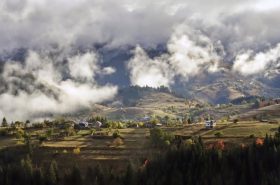Gorni Tsibar is a village in northwestern Bulgaria. It is located in Valchedram Municipality, Montana District. The population of Gorni Ciber is Romanian-speaking.
The village is landed on the territory of the Vatican lands with a special decree in 1812.

History of Gorni Tsibar
It emerges as a Roman fortress along the Mussay road from the Augusta / Hartez delta, Regiana / Cebrus / Pomodiana / Stanevo, Almus / Lom / and up. Its importance increases with the division of the province into two protectorates – Upper and Lower Moesia Moesia superior / Moesia inferior, for which the Tsibrza river serves. Here in 28 BC. the decisive battle between rebellious barbarian tribes and a great Roman army, led by the talented and cunning Mark Lizini Kras (junior) – grandson of the triumvirate of the same name. In the battle, the chief of the stalactites, Doldon, died. In the 2nd century the fortress was destroyed by barbarians and restored to Justinian.
The Roman stone road, which goes down to the mouth of one of the Cubar hamlets, is actively used until the Liberation.
The men of the village, although speaking the Romanian language, were loyal subjects of the kingdom and participated with the 15th Peshi Lomski polkha and in the composition of the First Bulgarian Army in all the wars, led in the Third Bulgarian Kingdom on the territory of the neighboring countries without Romania .
They give many sacrifices, incl. three people in the final phase of World War II on the territory of Hungary.
There is a great memorial in the courtyard of the local school.
In the September 1923 uprising, the criminal squadrons killed 10 insurgents from the village of Gorni Tsibar. The remains of the 5th of them emerge and are buried in a memorial ossuary in the center of the village.
In 1950 Gorni Tsibar was unveiled by the then Communist State Security a clandestine group of opponents of forced collectivization, acting as part of a large network of anti-communist farmers in northwest Bulgaria.
12 residents of G. Tsibar and surrounding villages were convicted, the Vratsa District Court issued 5 death sentences in Lom, of which 3 were executed.
In 1980, an old landslide became active on the site, destroying the water main, residential and public buildings, infrastructure.
By decision of the Council of Ministers of the Republic of Bulgaria, the residents of the village were compensated for property damage, with the recommendation to replace the village.
At present, permanent residents are about. 200 people, and former inhabitants and descendants are scattered in the surrounding settlements and all over Bulgaria.
Cultural and natural landmarks
On the territory of the village is part of the protected area “Island Tsibar”.
The mouth of the Tsibritsa river opens in a fan-shaped way, crossing the hills with a displacement of about 100 m. The rich variety of loess, pomelo, alluvial layers on an ancient landslide massif with cool northern exposure, a multitude of springs, natural ponds, a large acacia forest in the past, and all the panoramic views of the road above the village make an unforgettable impression. The spring “cherry waters” of the Danube often flood thousands of decares of the lowland, forming huge natural kennels of wild Danube carp, plateau, etc.
Characteristic are the ridge-shaped passages – unii (in Bulgarian they are called “funnels”) – artificially excavated Roman roads linking the Roman road Via Danubia passing through the Danube.
For the eastern border of the land so far served so. “Okope” – an earth-bulk protective fortification, oriented north-south from the Danube to the village of Hayredin and beyond.
Known from our history textbooks such as Asparuhov or Shishmanov shaft, it is most likely part of a protective system of the border mediaeval regions (two parallel shafts at Lom and Knezha, as well as in Oltenia; Yambol).
There is no direct information, but the later administrative divisions are consistent with this limit.







